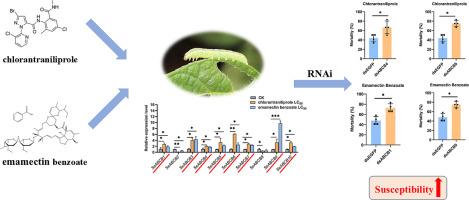夜蛾对氯虫腈和甲维菌素苯甲酸酯耐受相关ABCB转运基因的鉴定与验证
IF 4
1区 农林科学
Q2 BIOCHEMISTRY & MOLECULAR BIOLOGY
引用次数: 0
摘要
夜蛾是一种重要的入侵害虫,对多种常用杀虫剂产生抗药性。昆虫对杀虫剂的解毒作用可能部分依赖于atp结合盒(ABC)转运体。虽然ABCB亚家族基因在昆虫中的功能是多样的,但ABCB在S. exigua中的具体作用仍未被充分研究。本研究的重点是鉴定10个SeABCB基因,并表征它们在不同发育阶段和组织中的表达谱,以及对不同杀虫剂处理的反应。我们的研究结果表明,SeABCB基因在所有发育阶段都有表达,大多数ABC转运蛋白在蛹和成虫阶段的表达水平高于幼虫阶段。此外,在不同组织中均观察到高表达水平的SeABCB1和SeABCB6在中肠中更为丰富,而SeABCB3和SeABCB4在脂肪体中表达明显更高。SeABCB2、SeABCB5和SeABCB8在马尔比氏小管中表达显著,而SeABCB9在角质层中的表达水平高于其他组织。暴露于氯虫腈和甲维菌素苯甲酸酯后,8种ABCBs表达上调。基于RNAi的基因功能分析证实,SeABCB4和SeABCB9参与了仙瓜对氯虫腈的耐受性,而SeABCB1和SeABCB9参与了仙瓜体内苯甲酸埃维菌素的转运或代谢。总之,我们的研究提供了重要的见解,在解毒机制中的作用的seabcb。本文章由计算机程序翻译,如有差异,请以英文原文为准。

Identification and validation of ABCB transporter genes involved in chlorantraniliprole and emamectin benzoate tolerance in Spodoptera exigua
Spodoptera exigua is a significant invasive pest that has developed resistance to various commonly applied insecticides. The detoxification of insecticides in insects may partially depend on ATP-binding cassette (ABC) transporters. Although the functions of ABCB subfamily genes are diverse in insects, the specific roles of ABCBs in S. exigua remain largely unexplored. This research focused on identifying ten SeABCB genes and characterizing their expression profiles across various developmental stages and tissues, as well as in response to different insecticide treatments. Our findings indicate that SeABCB genes are expressed at all developmental stages, with most ABC transporters exhibiting higher expression levels during the pupal and adult stages compared to the larval stage. Furthermore, high expression levels of SeABCBs were observed in diverse tissues: SeABCB1 and SeABCB6 were found to be more abundant in the midgut, while SeABCB3 and SeABCB4 exhibited significantly higher expression in fat bodies. The expression of SeABCB2, SeABCB5 and SeABCB8 was notable in Malpighian tubules, and SeABCB9 showed a higher expression level in the cuticle than in other tissues. Eight ABCBs were upregulated in S. exigua following exposure to chlorantraniliprole and emamectin benzoate. Gene functional analysis based on RNAi proved that SeABCB4 and SeABCB9 are involved in the tolerance of S. exigua to chlorantraniliprole, while SeABCB1 and SeABCB9 participate in the transport or metabolism of emamectin benzoate in S. exigua. In summary, our research provides significant insights into the role of SeABCBs in the detoxification mechanisms of S. exigua.
求助全文
通过发布文献求助,成功后即可免费获取论文全文。
去求助
来源期刊
CiteScore
7.00
自引率
8.50%
发文量
238
审稿时长
4.2 months
期刊介绍:
Pesticide Biochemistry and Physiology publishes original scientific articles pertaining to the mode of action of plant protection agents such as insecticides, fungicides, herbicides, and similar compounds, including nonlethal pest control agents, biosynthesis of pheromones, hormones, and plant resistance agents. Manuscripts may include a biochemical, physiological, or molecular study for an understanding of comparative toxicology or selective toxicity of both target and nontarget organisms. Particular interest will be given to studies on the molecular biology of pest control, toxicology, and pesticide resistance.
Research Areas Emphasized Include the Biochemistry and Physiology of:
• Comparative toxicity
• Mode of action
• Pathophysiology
• Plant growth regulators
• Resistance
• Other effects of pesticides on both parasites and hosts.

 求助内容:
求助内容: 应助结果提醒方式:
应助结果提醒方式:


